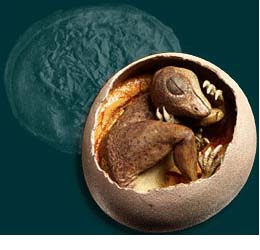
Dinosaurs are extinct (apart from their descendants the birds) and their eggs are represented today as fossils, in particular trace fossils. Trace fossils of dinosaurs are marks or indicators preserved in the rocks left by the particular vertebrate at a particular time. Other trace fossils include. They represent that product of egg laying activity and can offer clues to how dinosaurs behaved.
The dinosaur eggs went through a series of major events to become known to us today as fossils. After being laid, the egg was buried by a fine covering of sediment (maybe sand). This protected it from predation and scavenging and sealed it from the air (in particular oxygen) which would break it down and destroy the egg. Ground waters flowing through the sediment go through the egg and minerals precipitate from the solution into the egg.The original shell material is actually little altered during fossilization as it is made up of the mineral calcite which is stable (resistant to change) during the fossilization process, although it may be recrystallised. This outer shell is hard and made up of a series of interlocking units, a mosaic of plates, with pores which allow the passage of air in and out of the egg. This allows the baby to breathe.
The inside is not preserved during fossilization (apart from some rare dinosaur babies). However, there are some clues to what the inside of the eggs looked like. By looking at the nearest living relatives of dinosaurs today, such as the birds and crocodiles, we can estimate to what the inside of dinosaur eggs looked like. Housed inside the egg is a thick or viscous liquid which bathes the embryo and keeps it moist, preventing it from drying out. This allows the egg to be laid on land and is a feature of animals called amniotes - all reptiles, birds and mammals.
Amniotes can live on land due to this amniotic membrane, whereas amphibians do not have this ability and are restricted to the water to lay eggs.
Dinosaur eggs have been known for thousands of years, although at first they were not recognized as 'dinosaur eggs' and were used for jewellery and shaping ornaments. Many eggshells were found in late Palaeolithic or early Neolithic sites in Mongolia.The first real discovery of dinosaur eggshell was in 1859 from southern France, by Jean Jacques Pouech. The French eggs were thought to belong to giant birds at first, because of their large size. More complete eggs were found in 1869 by Matheron. He thought these eggs belonged to a giant crocodile. In 1877 Paul Gervais (1816-79) published the first detailed study of the eggs, and suggested that they could belong to a dinosaur. They are now known to have been laid by the sauropod dinosaur Hypselosaurus.In 1923 the Central Asiatic Expeditions of the American Museum of Natural History made significant new discoveries in the Gobi Desert, Mongolia. Roy Chapman Andrews found the first recognized dinosaur nests. The eggs were thought at that time to belong to Protoceratops but are now known to belong to Oviraptor.
Source from great site: http://www.rareresource.com
Read more interesting topic about dinosaur fossils.

0 comments:
Post a Comment